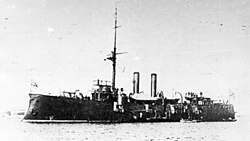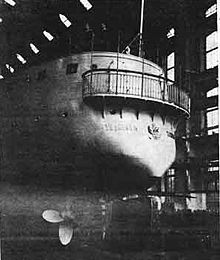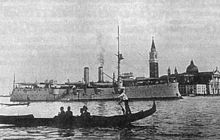Chiwinez
|
||||||||||||||||||
|
||||||||||||||||||
|
||||||||||||||||||
|
||||||||||||||||||
Chiwinez ( Russian Хивинец ) was the name of a sea-going gunboat of the Imperial Russian and Soviet Navy . Put into service in 1906, it served in the First and Second World War and was scrapped 1948th The name of the boat is the Russian name for a resident of the Central Asian city of Khiva .
Project and construction
The construction of the boat was already planned in the fleet armament program in 1898 for use in the Far East, but was not realized. The Chiwinez was only actually built as part of the armaments program for the years 1904–1914, but now it was to be designed for station service in the Mediterranean and the Persian Gulf . The American gunboat Helena served as a model for the construction .
On September 24, 1903, the boat was officially added to the list of the Baltic Fleet and on September 10, 1904, it was laid on the slipway of the New Admiralty in Saint Petersburg . In the keel laying was Grand Duke Alexei Alexandrovich (Алексей Александрович) present, on the same day, the construction of the mine transporter was Volga begun. The launch took place on May 11, 1905. The equipment work dragged on for a year, so that the commissioning took place in July 1906. The Chiwinez was the first Russian warship to have internal cooling. In terms of size and construction, it was similar to the Giljak , which was put into service in 1898 , but the Chiwinez did without the heavy mast construction of the Giljak , which had always given rise to concerns about its stability. Instead, the Chiwinez had a command tower immediately in front of the mast, which was 12-18 mm armored. The armament also did not differ fundamentally from that of the Giljak , but the ineffective 37 and 47 mm calibers were dispensed with, a second 120 mm cannon was installed and the 75 mm caliber medium artillery was reinforced. The heavy artillery was placed on center pivot mounts on deck, the 75 mm cannons in bay windows. The advantage of the open installation was the large swivel range of the guns, which was only limited by the superstructure. The disadvantage was the protection only by swiveling protective shields, which only protected them against splinters and small-caliber projectiles. However, since the boat was not intended for use in the battle line, it was believed that this, as well as the weak armor, could be accepted. Because of the constructive similarities, the Chiwinez is sometimes assigned to the Giljak class in the literature.
commitment
After commissioning, the boat was sent to Crete for station service. On September 23, 1906 the boat left Kronstadt and reached Suda Bay on November 8. In February of the following year, the Chiwinez helped rescue the passengers of the Austrian steamship Kaiserin, which was stranded in front of Elafonisos .
In June 1912, the Chiwinez in the Mediterranean was replaced by the Donez gunboat and moved to Sevastopol for repairs . For the passage of the Dardanelles and the Bosporus, foreign warships required a permit from the government of the Ottoman Empire , which was also granted in the case of the Chiwinez . In Sevastopol, the boat underwent major repairs to the hull, and at the same time the water pipes of the boiler system were replaced. A second signal mast was also erected on this occasion. The repair work was completed on October 12, 1912. Then the boat moved back to Suda Bay. In 1913 the boat was assigned to the training units of the Baltic Fleet. The Chiwinez left Greece on January 27th and returned to Kronstadt on April 25th.
First World War
At the beginning of the First World War, the Chiwinez was used in the Abo - Åland position in the Gulf of Finland . The position was part of an extensive system of fortifications , minefields and operational areas for ships, which was intended to protect the sea access points of the Russian capital. The gunboats were responsible for covering the minefields and protecting the sea areas that could not be covered by the coastal guns . (see sea fortress of Emperor Peter the Great ). In 1915/16 the boat was repaired again. The armament was supplemented by two 120 mm cannons and anti-aircraft cannons , but the 75 mm cannons were omitted. The two 120 mm guns were removed from the Korejez II gunboat . The Chiwinez was then used again in the Abo Åland position, later in the Riga Bay .
On September 30th Jul. / October 13, 1917 greg. received the Chiwinez , which was with the Chrabry in Arensburg , the order to move to the Kassaer Wiek, in which German ships had been sighted. The German ships were among the forces involved in the Albion operation. On the same day at around 1 p.m., the boat launched an attack against the German minesweepers operating in the Soelo Sound, but this was repulsed by fire from the supporting small cruiser Emden . On October 1st, Jul. / October 14, 1917 greg. At 1:45 p.m. the Chiwinez with the Chrabry and minesweepers took up the fight again with the German minesweepers working in the Kassaer Wiek and was able to stop them for a short time, but then moved with the other Russian ships in front of the superior German units to the southeast back. During the operation, neither the commander nor another staff officer were on the Khivinez , the boat was led by Lieutenant Afanasyev (Afanasev).
On October 28th, Jul. / November 10, 1917 greg. the crew placed the boat under the newly formed Red Baltic Fleet. From April 1918 it was used to protect the eastern and central sections of the Neva in the urban area of Petrograd and took up position near the Neva bridges. In 1919 the boat was decommissioned for the time being and laid up in the Kronstadt naval port.
In 1922 the boat was upgraded at the Neva factory and put back into service with the training unit of the Baltic Fleet. (According to other sources, however, it is said to have stood with the Azov flotilla in battle against General Wrangel's troops in 1920 and sunk the gunboat Salgir (Салгир) in a battle on September 15, 1920 against superior enemy forces . According to Dozenko, however, it is not about the Chiwinez , but about the former Prahm Egurtscha (Егурча)). On December 31, 1922 it was named Red Star - Krasnaya Zvezda (Красная Звезда). In the summer of 1928 the boat was disarmed and converted into a self-propelled floating base for the ships of the Baltic Fleet. In this capacity, it also took part in the Second World War. In June 1944 it was removed from the fleet list again, but this time for good, and broken up in 1948.
literature
- А. Г. Больных: Морские битвы Первой мировой: Трагедия ошибок , АСТ, 2002 (AG Bolnych: The naval battles of the First World War: A tragedy of mistakes ) (Russian)
- А. В. Скворцов: Канонерские лодки Балтийского флота “Гиляк”, “Кореец”, “Бобр”, “Сивуч”, (AW Skworzow: The gunboats of the Baltic fleet )
- Ю .В. Апальков: Ю.В.Апальков: Российский Императорский Флот 1914–1917 гг. Справочник по корабельному составу , Харвест, 2000, ISBN 985-433-888-6 (Ju. W. Apalkow: Die Kaiserlich-Russische Flotte 1914–1917. List of ships ) (Russian)
- А. Тарас: Корабли Российского императорского флота 1892–1917 гг , Харвест, 2000, ISBN 985-433-888-6 (A. Taras: The Ships of the Imperial Russian Fleet 1892–1917 ) ( 1892–1917 )
- Андрей Гавриленко: Морские мили "Красной звезды" , Красная звезда, 26 Августа 2009 года (A. Gawrilenko: Morskije Krasnoi , August 26, 2006) in Russian "Krasna" swedish "Krasna" .
- В. Доценко: Гражданская война в России: Черноморский флот, ACT, 2002. ISBN 5-17-012874-6 (W. Donezko (ed.): The Civil War in Russia: The Black Sea Fleet )
Web links
- Technical data, drawings and photo (Russian)
- Technical data and photos (Russian)
- Krasnaya Zvezda on the website of the Baltic Fleet (Russian)
Footnotes
- ↑ Р. М. Мельников: Крейсер "Очаков" , Судостроение, 1986 (RM Melnikow: cruiser "Otschakow" , Sudostrojenije, 1986)
- ↑ see Skworzow, p. 34f
- ↑ Отчет о действиях Морских сил Рижского залива 29 сентября - 7 октября 1917 г. М.К. Бахирев (Report on the fighting in the Riga Bay from September 29 to October 7, 1917 by Vice Admiral Bachirev )
- ↑ В. П. Кусков: Корабли Октября , Лениздат, 1984 (WP Kuskow: Ships of October, Lenizdat, 1984)
- ↑ see Gwarilenko
- ↑ В. Доценко: Гражданская война в России: Черноморский флот, ACT, 2002. ISBN 5-17-012874-6 (W. Dozenko (ed.): The Civil War in Russia: The Black Sea Fleet )



